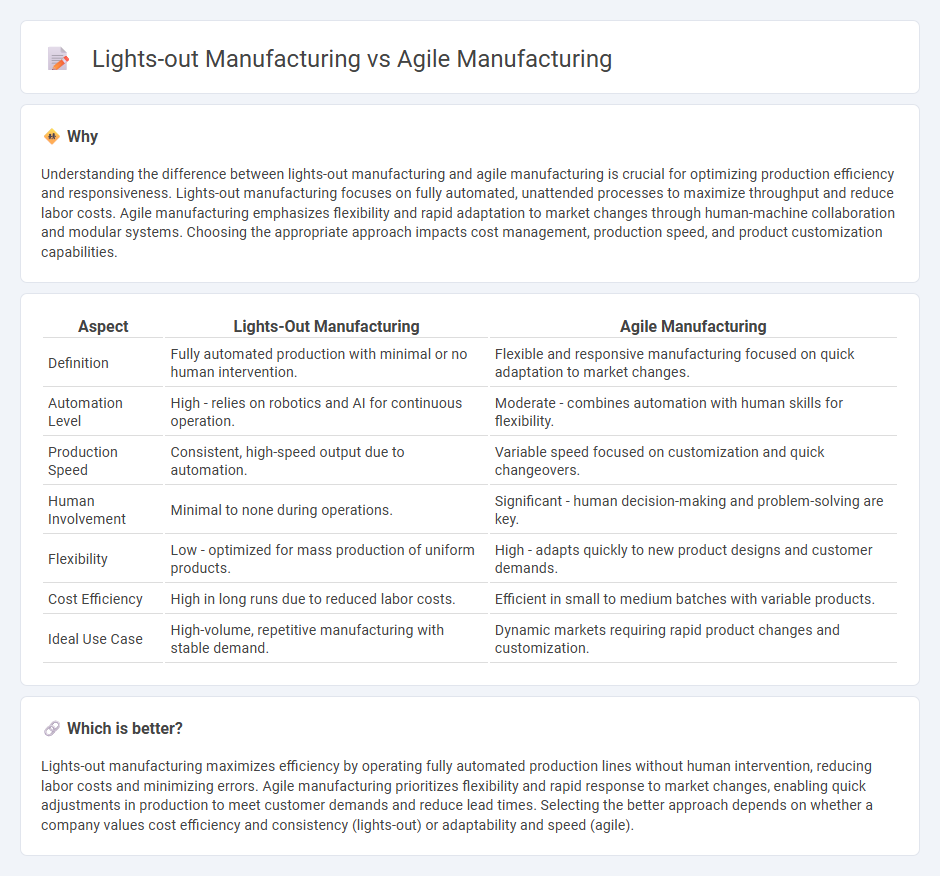
Lights-out manufacturing utilizes fully automated, robot-driven production processes operating without human intervention, significantly reducing labor costs and increasing precision. Agile manufacturing focuses on flexibility and rapid response to market changes by integrating human oversight, adaptable machinery, and real-time data analytics. Explore the distinct advantages and applications of these advanced manufacturing methods to optimize your production strategy.
Why it is important
Understanding the difference between lights-out manufacturing and agile manufacturing is crucial for optimizing production efficiency and responsiveness. Lights-out manufacturing focuses on fully automated, unattended processes to maximize throughput and reduce labor costs. Agile manufacturing emphasizes flexibility and rapid adaptation to market changes through human-machine collaboration and modular systems. Choosing the appropriate approach impacts cost management, production speed, and product customization capabilities.
Comparison Table
| Aspect | Lights-Out Manufacturing | Agile Manufacturing |
|---|---|---|
| Definition | Fully automated production with minimal or no human intervention. | Flexible and responsive manufacturing focused on quick adaptation to market changes. |
| Automation Level | High - relies on robotics and AI for continuous operation. | Moderate - combines automation with human skills for flexibility. |
| Production Speed | Consistent, high-speed output due to automation. | Variable speed focused on customization and quick changeovers. |
| Human Involvement | Minimal to none during operations. | Significant - human decision-making and problem-solving are key. |
| Flexibility | Low - optimized for mass production of uniform products. | High - adapts quickly to new product designs and customer demands. |
| Cost Efficiency | High in long runs due to reduced labor costs. | Efficient in small to medium batches with variable products. |
| Ideal Use Case | High-volume, repetitive manufacturing with stable demand. | Dynamic markets requiring rapid product changes and customization. |
Which is better?
Lights-out manufacturing maximizes efficiency by operating fully automated production lines without human intervention, reducing labor costs and minimizing errors. Agile manufacturing prioritizes flexibility and rapid response to market changes, enabling quick adjustments in production to meet customer demands and reduce lead times. Selecting the better approach depends on whether a company values cost efficiency and consistency (lights-out) or adaptability and speed (agile).
Connection
Lights-out manufacturing and agile manufacturing both enhance production efficiency by leveraging automation and flexibility in operations. Lights-out manufacturing relies on autonomous systems operating without human intervention, aligning with agile manufacturing's adaptability to rapidly changing market demands. Together, they optimize throughput, reduce downtime, and improve responsiveness in modern manufacturing environments.
Key Terms
Flexibility
Agile manufacturing emphasizes adaptability and rapid response to changing customer demands by integrating cross-functional teams and flexible production processes. Lights-out manufacturing focuses on fully automated, unmanned production, maximizing efficiency but often sacrificing flexibility due to reliance on fixed robotic systems. Explore the distinctive benefits and challenges of both methods to determine the best fit for your manufacturing needs.
Automation
Agile manufacturing emphasizes flexibility and quick adaptation through human-machine collaboration and automated systems, enhancing responsiveness to market changes. Lights-out manufacturing relies entirely on automation and robotic systems operating without human intervention, enabling continuous, unattended production. Explore how integrating these automation strategies can optimize manufacturing efficiency and innovation.
Human Involvement
Agile manufacturing emphasizes flexibility and rapid response, relying heavily on human skills for decision-making, customization, and problem-solving. Lights-out manufacturing operates autonomously with minimal or no human presence, utilizing robotics, AI, and automated systems to increase efficiency and reduce labor costs. Explore the distinct roles of human involvement within these manufacturing paradigms to understand operational impacts and strategic advantages.
Source and External Links
What Is Agile Manufacturing? Lean vs. Agile - Agile manufacturing is a methodology that emphasizes rapid response to customer demands by turning speed and agility into competitive advantage, integrating lean manufacturing principles like small batch production and continuous improvement to outperform offshore competition through local rapid delivery and personalization.
Agile Manufacturing: Benefits, Challenges, and Key ... - Agile manufacturing prioritizes responsiveness to customer demand through speed, agility, and innovation, exemplified by Dell's direct sales and just-in-time production model leading to significant improvements in product quality, productivity, and cycle times.
Agile manufacturing - Agile manufacturing is a modern approach enabling companies to respond swiftly and flexibly to market changes while maintaining quality and cost control, often combined with lean manufacturing to balance efficiency and adaptability through strong supplier networks and quick production adjustments.
 dowidth.com
dowidth.com